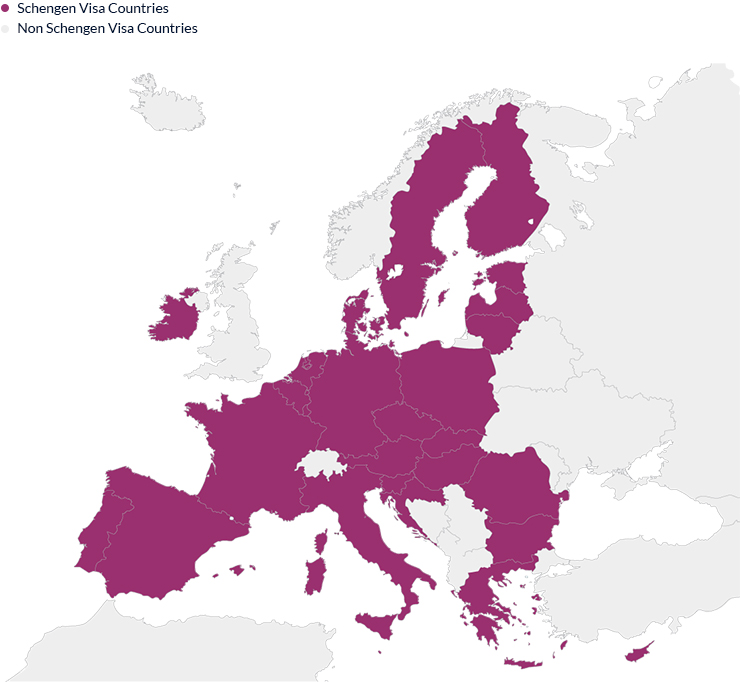Schengen area countries
On June 14th 1985, governments of France, Germany, Belgium, Luxemburg, and Netherlands signed the Agreement on the gradual abolition of checks at common borders, followed by the signing on June 19th 1990 of the Convention implementing that Agreement. The implementation of the Schengen Agreements started in 1995.
Today, there are 26 Member States of the Schengen Area.

The Schengen Area Member States are:
- Germany
- Austria
- Belgium
- Czech Republic
- Denmark
- Slovakia
- Slovenia
- Spain
- Estonia
- Finland
- France
- Greece
- Hungary
- Iceland
- Italy
- Latvia
- Liechtenstein
- Lithuania
- Luxembourg
- Malta
- Netherlands
- Norway
- Poland
- Portugal
- Sweden
- Switzerland
Abolition of borders between these European countries resulted in:
- Free travel throughout the Schengen area, without the passport and other controls
- Common rules and standards for the outside borders of the Schengen area
- Harmonisation of the visa regime and conditions for the visits to the Schengen area
- Joint register of persons
- Strengthened police and legal cooperation among the member states
- Implementation of the Visa Information System (VIS) as the means for the exchange of information about the visa applicants. The information on the identity of applicants and the reported purpose of the travel is exchanged by cross-referencing the applicants’ biometric data. This supports the safety of the Schengen countries and the European Union. This system is used when issuing short-stay Schengen visas and the transit visas. The identity checks of the travellers by cross-referencing the data in the Visa Information System and the asylum request checks also ensure the safety of the Schengen area countries.
- Implementation of the Schengen Information System (SIS) which supports the safety of the Schengen area and the exchange of information about criminals and missing persons. The police cooperation among the Schengen countries is ensured, inter alia, by cross-matching fingerprints and digital photos of the visa applicants. Another advantage of this system is the control of vehicles which move through the Schengen area and the European Union, as a way to prevent car thefts and locate stolen vehicles.
- Implementation of the European Dactyloscopy (EURODAC) as a mechanism which ensures the safety of the Schengen area in the form of a fingerprint database. This database is used in case of asylum requests in the Schengen area countries. The applicant’s fingerprints through EURODAC are communicated immediately, each time he/she applies for asylum everywhere in the EU. This system helps prevent crime and terrorism. This system, however, does not examine asylum applicants or cross borders over the age of 14.
In case of a serious threat to the safety of any of the countries in the Schengen area, the border controls may be reintroduced at some internal borders.
The population of the Schengen Area is over 400 million. This area covers 4.312.099 km². The external borders of the Schengen Area are 50,000 km long.
- The Schengen Area has 26 member states.
- 22 of them fully implement the Schengen Acquis
- 4 of them are members of the European free Trade Association (EFTA)
- 3 of them are associated members of the Schengen Area but are not members of the European Union (Island, Norway and Switzerland).
- The Azores, Madeira and the Canary Islands are special members of the EU and part of the Schengen Area, but located outside Europe.
- Monaco, San Marino and Vatican City are in Europe but are not members of the Schengen Area.
- Ireland and United Kingdom are not members of the Schengen Area.
Most Schengen countries are in the European Union, but do not confuse the EU with the Schengen Area.
Countries such as Romania, Bulgaria, Croatia and Cyprus are in the process of joining the Schengen Agreement. There are some pre-conditions that countries must have the capacity, such as:
- To be able, to control the external borders of the Area as well as to issue Uniform Schengen Visas
- To possess the competence that after the abolishment of border controls between Schengen countries, to collaborate with other Schengen countries’ law enforcement agencies for a greater level of security
- To be equipped in applying Schengen rules for controlling land, sea and air borders, issuing short-stay Schengen visas, police collaboration as well as protection of personal data
- To be ready to join and put in use the Schengen Information System (SIS)
